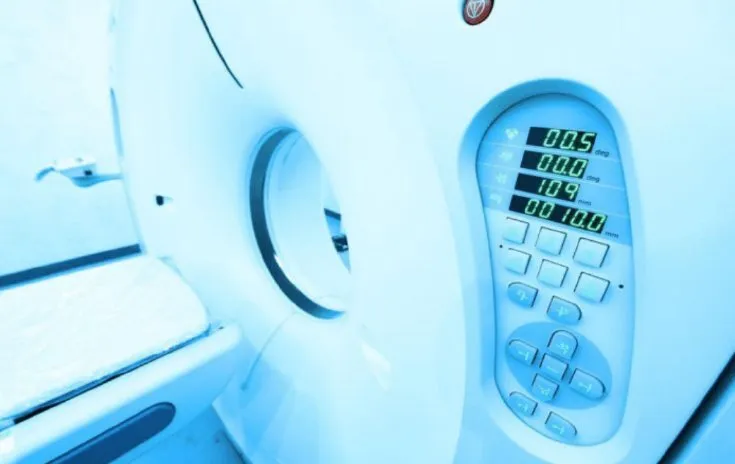Like any other business purchase, your goal when choosing a Computed Tomography (CT) scanner for your practice should be to find a system that has the features you need while paying as little as possible. It is important to remember, though, that there is more than just the upfront price of the equipment that goes into the overall cost of ownership. In fact, extended warranty and service make up about 35% to 50% of the total cost of a CT over a 10-year period—and if you’re buying a CT, you want it to last about that long. A CT scanner is a sizable investment for even the busiest veterinary clinics, and so to reduce the upfront cost, the veterinary industry has evolved to offer scanners that fall into two main categories:
- New
- Used
- Manufacturer Refurbished
- 3rd Part Reconditioned
But which of these really offers a better Return On Investment (ROI? Let’s examine the facts:
New CT Scanners
New systems are purchased either directly from the manufacturer or from an authorized distributor. They have the lowest risk of failure, so the extended warranty packages tend to be less expensive than those for used CT scanners. New systems are also much more reliable and
safer—especially compared to scanners that were reconditioned by a company not affiliated with the manufacturer.
Extended warranties for new CT systems are less expensive for veterinary clinics than for human hospitals because the scanners will be used less. That translates into less wear-and-tear on the X-ray tube and gantry (the biggest, most expensive moving parts of the CT). In most cases though, new CT scanners are too expensive to be feasible for the average veterinary caseload
to substantiate.
Used CT Scanners
To reduce the cost, many veterinary clinics purchase used CT systems from human hospitals. Before you go this route, though, consider the logistics; that CT scanner has most likely been used around the clock for 8 to 12 years, at which point the system either broke down to the extent that it was not cost effective to fix, or it was considered outdated technology for human applications. In both cases, the human hospital determined that purchasing a brand-new scanner to the tune of about $1 million was a smarter option than pouring more money into the system.
This doesn’t necessarily mean that a used scanner is a bad investment; the opposite is in fact true for most veterinary practices. But it does mean that you should not buy a used system unless you are confident that it has been sufficiently restored and operating at peak efficiency.
There are two categories of restored CT scanners: “refurbished” and “reconditioned.” It is important that you know the difference between the two if you want to ensure patient safety and maximize your ROI.
Refurbished vs. Reconditioned CT Scanners
Refurbished CT scanners have been restored by the manufacturer and put through the same performance evaluations as new systems. They tend to be more reliable, safer, and more durable than reconditioned scanners, which were restored by a company that is not affiliated with
the manufacturer.
Reconditioned scanners can be dangerous because they do not undergo the manufacturer’s performance evaluations. Although the third party company will have its own testing process, it is likely very different than—and inferior to—the manufacturer’s process. There are tons of intricate alignments, calibrations, and configurations in both the system and the testing equipment that the manufacturers do not publish because they want the restoration income for themselves.
Refurbished CT scanners are usually a smarter investment because the manufacturer who built the equipment in the first place has the right tools, parts, experience, and facilities to dissemble the system, assess the components individually, and replace or repair them as needed with parts that are specifically designed for that system (vs universal, off-the-shelf components). However, refurbished CTs are typically more expensive than reconditioned systems, and their extended service contracts tend to cost more than those for new CTs.
SOUND TOP TIP
Before purchasing any used system, whether manufacturer refurbished or 3rd party reconditioned, ALWAYS find out the serial number of the system. You can then call the manufacture directly with this information to find out the vintage of the system and its installation history.
Conclusion
A new CT scanner is ideal for large clinics that have the budget and caseload to justify the investment. If you have a small or medium-sized clinic, a refurbished CT scanner might be the best option because you will have the confidence of purchasing a system that has passed the manufacturer’s tests, and the upfront price will be slightly lower than a new CT.
Reconditioned systems should only be purchased from well-established restoration companies. Even then, serious diligence into the history of that particular system should be done to better understand the degree of reconditioning was performed before installation in your clinic.
If you would like more information about the installation requirements associated with veterinary CT, call SOUND® at 800-268-5354. You can learn more about SOUND®’s CT systems by following these links >>> CereTom® CT | BodyTom® CT

